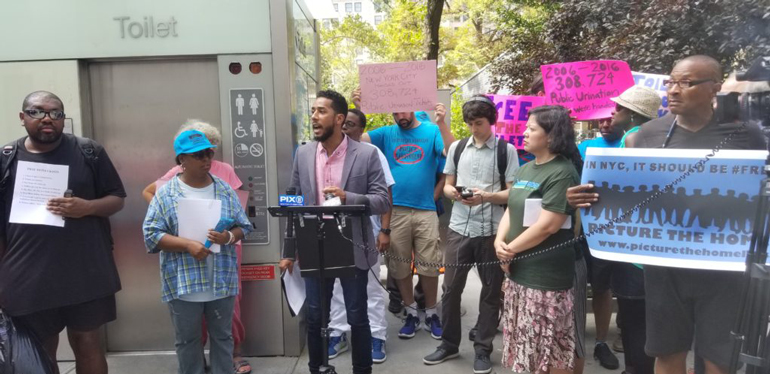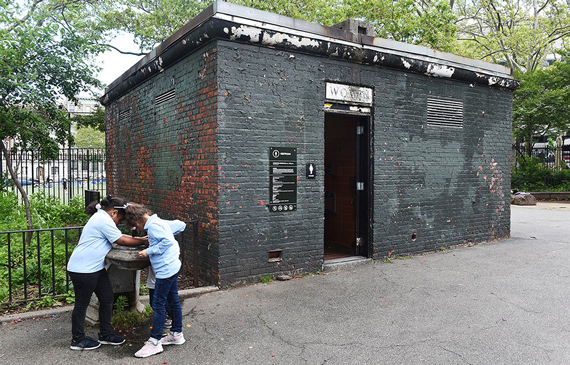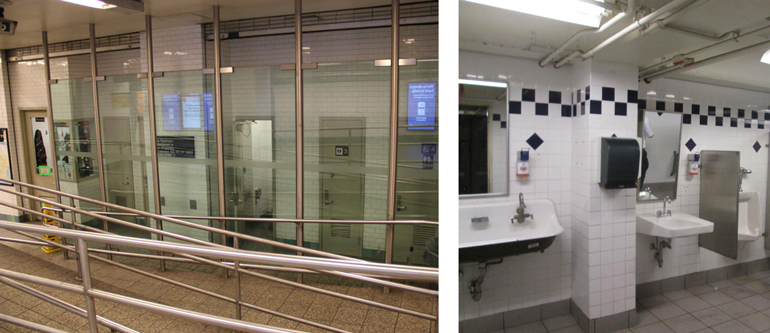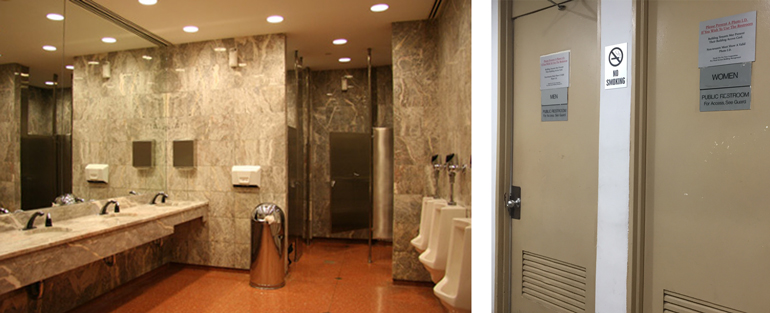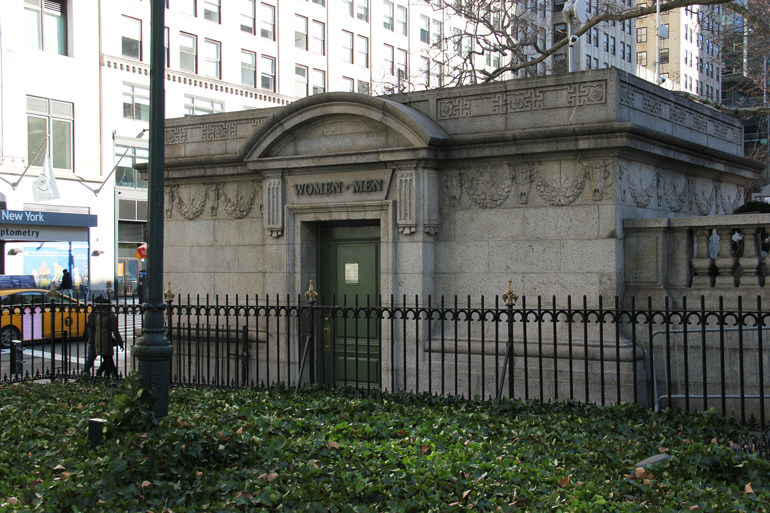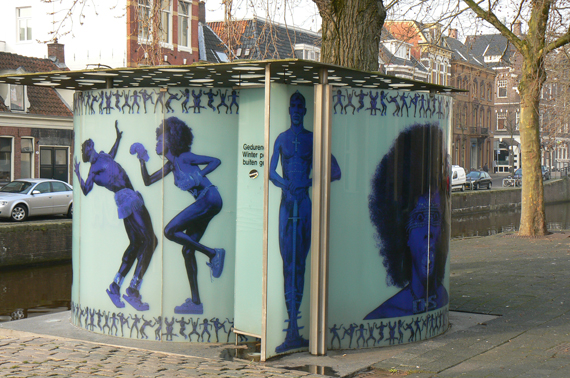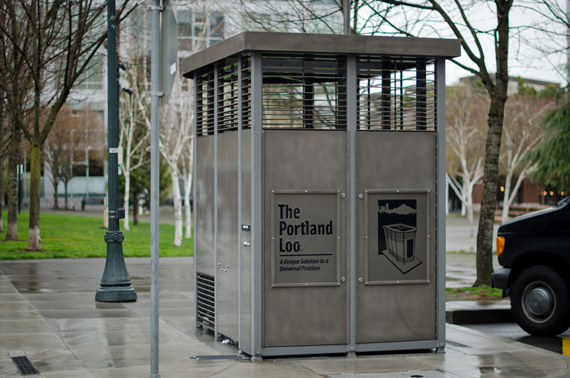
We are celebrating 15 years — and counting — of stories that are deeply researched and deeply felt, that build a historical record of what the city has been.
We are celebrating 15 years — and counting — of stories that are deeply researched and deeply felt, that build a historical record of what the city has been.
We’ve written before about the importance of public bathrooms for participation in public life. In the 1930s, New York City dramatically expanded its public restroom infrastructure, with renovating and building new comfort stations in parks across the city. In 2020, the picture is not so rosy. Austerity-driven public bathroom closures in the 1970s, followed by a reliance on lightly regulated public-private-partnerships and a host of other problems, have left us with just 1,103 public bathrooms — for a city of almost 8.5 million residents, and nearly 63 million tourists per year. Just two are open 24/7. This was the discovery of a group of researchers making the case for New York City’s urgent need for public bathrooms. As part of the Urban Design Forum’s Forefront Fellowship focused on homelessness, “Shelter for All,” Julie Chou, Kevin Gurley, and Boyeong Hong learned about the dire consequences for the city’s homeless population, from UTIs to summons for public urination. A dearth of public bathrooms also spells trouble for tourists, pregnant women, children and their caretakers, and a host of other bodies.
Below, we share highlights from their survey of the city’s public bathrooms — in parks and subways, plazas and pools. Some are inaccessible, in bad shape, or don’t feel safe, while others could be models for a vastly improved and increased network of relief. A booklet also discusses best practices and proposes design guidelines for future facilities. The authors hope to get the attention of the city’s community boards and elected officials — and it seems change could be coming. Last June, the Office of the New York City Comptroller issued a report looking at the state of city parks’ comfort stations, and the dramatic need for maintenance, upgrades, and new construction. The city’s Department of Consumer and Worker Protection is considering a proposal to incentivize private businesses to open up their restrooms to the public. A new magazine about bathrooms, Facility, has launched a public conversation on the taboo topic (and is posting codes to bathrooms at private establishments across the city). Perhaps the “unheralded workhorse of the public sphere” is finally starting to garner the attention and care it has long deserved.
There are 1,103 public bathrooms around New York City. However, only two of these facilities are open 24/7, creating a serious problem for anyone looking for a bathroom late at night.
In 2018, the New York City-based, nonprofit organization Picture the Homeless (PTH) began a campaign called “Free to Pee.” Advocating for greater access to public restrooms, PTH noted that “this is not just a homeless issue . . . this is a New Yorker issue. This is a tourist issue. This is a women’s issue. This is an everybody-that’s-gotta-pee issue.” They also observed that “for homeless people, a little thing like needing to go to the bathroom can cause big problems. Buying a four-dollar coffee to use a bathroom in a cafe is not always an option. Many homeless people have had medical emergencies or police interactions as a result.” Refusing people bathroom access remains a remarkably effective form of social exclusion.
In a city as large, dense, and diverse as New York, there is a significant need for easily accessible, clean, and safe public bathrooms. This is not a new issue: Four mayoral administrations and a number of advocacy groups have tried to provide greater access to public bathroom facilities in recent decades. New Yorkers seem to understand that there is an unmet need. However, past initiatives have proven unsuccessful. Why haven’t these efforts worked?
Historically, “public” bathrooms referred only to restrooms in noncommercial, public spaces for use by people who did not yet have a toilet in their home. One of the earliest public bathrooms in the United States was built in Astor Place in 1869. It would be the first of many more in a fast-growing immigrant city, at a time when private access to a toilet was considered a luxury. In the 1930s, Robert Moses became New York City’s first Parks Department Commissioner, leading the effort to construct new “comfort stations” in public parks and recreation facilities around the city, and to establish an impressive network of pools and showers for public use. Many of these facilities are still open today.
However, several public bathrooms closed in the decades following World War II. The 1970s were a particularly challenging time for New York City. Facing significant budget shortfalls and narrowly avoiding bankruptcy, the city enacted harsh budget cuts, and public bathrooms were one victim of financial austerity. Many public bathrooms closed due to increasing maintenance and security costs, as some facilities became magnets for crime, vandalism, sexual activity, and drug use. Meanwhile, the responsibility of maintaining public bathrooms began to fall increasingly on local businesses and property owners. Throughout the 1980s, the Department of City Planning asked private developers to provide public bathrooms as part of the construction of privately owned public spaces (POPS).
In 1990, a group of homeless people sued the City of New York and the Metropolitan Transportation Authority (MTA) for lack of access to public bathrooms. As the New York Times reported at the time: “The suit charges that the plaintiffs are ‘forced to endure continual embarrassment, humiliation, physical injury, and hazardous conditions resulting from defendants’ violations.’ It said the plaintiffs, three men and a woman, were harassed because of their need to relieve themselves in public and were subjected to physical pain because of inability to relieve themselves promptly.” The lawsuit resulted in the 1992 formation of the Public Toilets Working Group, and Mayor Dinkins approved a four-month test period for six self-cleaning sidewalk bathrooms. Though these bathrooms were used over 40,000 times, and attendants reported positive feedback from users, roadblocks such as New York City’s extensive land use review process eventually defeated this initiative. There were several attempts under the Giuliani and Bloomberg administrations to install more of these self-cleaning facilities, but to date, a total of only five sidewalk toilets are installed and open to the public. The availability of public bathrooms has not increased significantly since the crisis years of the 1970s, and despite population and economic growth — and millions of tourists visiting the city annually — existing bathroom conditions have changed very little in recent decades.
Today, there are multiple, distinct types of public bathrooms located throughout the city, each with their own strengths and weaknesses.
New York City has over 1,700 public parks. 662 of those feature public bathrooms known as “comfort stations.”
In 2019, the Office of the New York City Comptroller published a report on the existing conditions of comfort stations, noting that nearly 400 fixtures were damaged or missing, and over 50 “hazards” such as exposed wires or noxious odors had been reported. Within nine community districts, more than 25 percent of NYC Parks bathrooms were deemed “unacceptable.”
Many new comfort stations are being built around the city, including those commissioned by the city’s Design and Construction Excellence program. While designed to be clean, safe, and attractive, each comfort stations costs the city an average of $5 million to construct, at over $5,000 per square foot. In November 2019, NYC Parks decided to look into stand-alone bathroom units, trailer-like bathrooms, or automatic public toilets as more cost-effective options.
Of the MTA’s 472 subway stations, 78 have accessible public bathrooms. Service hours for these facilities are limited to the daytime only (generally from 5am to midnight) despite 24/7 subway service. Many other stations have bathrooms, closed to public use, that could be rebuilt, renovated, and reopened.
Subway station bathrooms are fairly well distributed throughout the city, forming an important part of the city’s public bathroom network. Although several of these facilities are heavily used, others are located in quieter, less-transited areas of stations, creating safety concerns for some users. Furthermore, many subway station bathrooms are poorly maintained, dirty, or simply lacking basic amenities. However, examples of clean, safe bathrooms can be found at 34th Street–Hudson Yards, Fulton Street, and the Second Avenue Line stations in the Upper East Side.
The public bathrooms at the Times Square–42nd Street subway station were built in 1992 by Boston Properties, the developer of the Times Square Tower, in exchange for further development rights. As requested by the MTA and local retailers during the approval process for this deal, Boston Properties pays the Times Square Alliance (a local business improvement district) to provide full-time attendants to clean and monitor the bathrooms. These facilities are popular with locals and tourists alike.
There are five Automatic Public Toilets (APTs) installed in Department of Transportation (DOT) plazas or adjacent to parks in the Bronx, Brooklyn, Manhattan, and Queens. These bathrooms are self-cleaning and fully accessible.
In 2006, DOT signed a $1.4 billion deal with Spanish advertising company Cemusa to provide 3,500 bus stop shelters, 330 newsstands, and 20 APTs in exchange for advertising rights for a period of 20 years. Though all the promised bus stops and newsstands have been installed, 15 APTs remain in storage. The challenges of installing these bathrooms include difficulty accessing utility connections, pushback from local community groups, and the Public Design Commission’s approval process. Meanwhile, the costly installation and maintenance of APTs, compared to bus stops and newsstands, provides less of an incentive for Cemusa to move forward with setting them up.
APTs cost 25 cents for 15 minutes of privacy, after which the doors pop open (a warning light and alarm go off when there are only three minutes left). An automatic arm sprays water and disinfectant over the toilet, then blow dries it. Maintenance workers clean and lock the bathrooms every night. Though a lack of public awareness and regular maintenance impairs the full success of APTs, a robust network of these facilities installed across the city could present an immense opportunity for increasing access to public bathrooms.
14 of the city’s 550 POPS include public bathrooms. All of these facilities are in predominantly large, high-rise projects built during the 1980s, and located in dense, wealthy areas of Manhattan such as Midtown and the Financial District.
The POPS program, introduced in 1961, has created 3.8 million square feet of public space in New York. Overseen by private landowners and management companies, most of these spaces are nicely designed and well maintained, and since POPS require a security guard on site, their bathroom facilities provide a sense of safety to some users. Zoning regulations stipulate that POPS plazas greater than 10,000 square feet must provide food service as an amenity, which helps bring more foot traffic and increases the visibility of the city’s few POPS bathrooms. However, POPS are not required to provide public bathrooms. Beyond their exclusive location in Manhattan’s central business districts, access to POPS bathrooms can be quite limited. They are usually open during daytime hours only, while some are always locked, requiring a security guard to unlock them.
There are 88 outdoor public pools and 14 indoor public pools in New York City. All of these facilities feature public bathrooms and showers.
Public pools are an already well-used recreational infrastructure, and having these facilities’ bathrooms and showers open to the general public provides a great benefit for those living on the streets. Facilities are actively maintained and monitored daily, ensuring a safe and clean environment. Attractive designs coming out of the Cool Pools NYC program include wall art, lounge chairs, umbrellas, and plantings. However, free outdoor pool facilities are only operated during the summer season, and though pool facilities provide locker space, they do not provide sturdy locks. Those living on the street may also feel reluctant to use pool bathrooms due to social stigma. In cities such as Seattle and Berkeley, public pools have set aside certain hours of the week year-round to provide showers and restrooms for children and families experiencing homelessness.
The city has five drop-in centers located in Manhattan, Brooklyn, Staten Island, and the Bronx. Two of these centers are open 24/7, while the others have limited hours of operations. Drop-in centers offer many services to those experiencing homelessness, including hot meals, showers, bathrooms, laundry facilities, clothing, medical care, recreational space, employment referrals, and other social services.
Drop-in centers are well staffed and regularly maintained, and there is no front door requirement for screening people based on their housing history. However, these sites do have security personnel, and staffing needs increase operational costs. Due to the institutional atmosphere of drop-in centers, some people may feel hesitant to walk in, particularly to use a bathroom or shower.
Three public bathrooms in New York City are managed by business improvement districts (BIDs). BIDs help drive foot traffic in commercial areas, and clean and maintain nearby public spaces. The most popular and well-known public bathroom in the city is maintained by a BID: the Beaux Arts-style comfort station in Bryant Park, overseen by the Bryant Park Corporation. This recently renovated facility has an average of 3,266 daily users, and over 1.2 million visitors a year. Demand is so high that lines can grow to 40 people or more. The bathroom has full time attendants and features state-of-the-art toilets, crown moldings, paintings by local artists, fresh flower bouquets, and recordings of classical music.
34th Street Partnership manages the city’s two other BID public bathrooms, located at Greeley Square Park and Herald Square. Originally installed as APTs in 2001, the BID replaced both facilities with manual toilets in 2009, believing these would be cleaner, safer, and not much more expensive than the self-cleaning toilets.
For a city of about 8.4 million people, 1,100 total bathrooms comes out to just one public bathroom for every 7,700 New Yorkers. For large assemblies, the Uniform Plumbing Code requires one toilet for every 500 people. The United Nations standard for refugee camps is one toilet for every 20 people. In New York, there are more than 3,675 people living on the street, which would require as many as 183 toilets — a number that would be higher if we consider homeless people who are able to obtain shelter at night, but still largely spend their days outside.
Though there are no one-size-fits-all solutions for addressing the public bathroom crisis in New York City, we have developed some suggestions for creating more quality public bathrooms to address the needs of all New Yorkers, as well as the 60 million annual tourists that visit the city. Our proposals, published in the booklet The Need for Public Bathrooms, include opening new facilities through more cost-effective options, utilizing existing infrastructure or public-private partnerships, extending hours, increasing maintenance, including more visible signage, or some combination of these strategies.
We suggest that the City of New York look to Washington DC’s Public Restroom Facilities Installation and Promotion Act of 2018, which mandated two popular and proven public bathroom models. The first calls for the installation of stand-alone bathroom structures designed to address cost effectiveness, safety, and maintenance issues. The second is a program based on the Community Toilet Scheme in London, in which retailers are provided an annual stipend and other incentives to open up their bathrooms to the public.
The Occupational Safety and Health Act (OSHA) requires employers to provide their employees with bathroom facilities so that they will not suffer from adverse health effects that can result if bathrooms are not available. The US Department of Health and Human Services, however, provides no such protection for the general public. We want to change this. We want our legislative bodies to know that public bathrooms are a need, and not an option.
We propose that the City of New York form an interagency effort to study and address the need for public bathrooms, and to create a multipronged effort using various public bathroom types.
We also call on our local city representatives to protect our rights to public restrooms so that all New Yorkers have access to clean and safe public bathrooms.
All maps created by the authors.
The views expressed here are those of the authors only and do not reflect the position of The Architectural League of New York.
